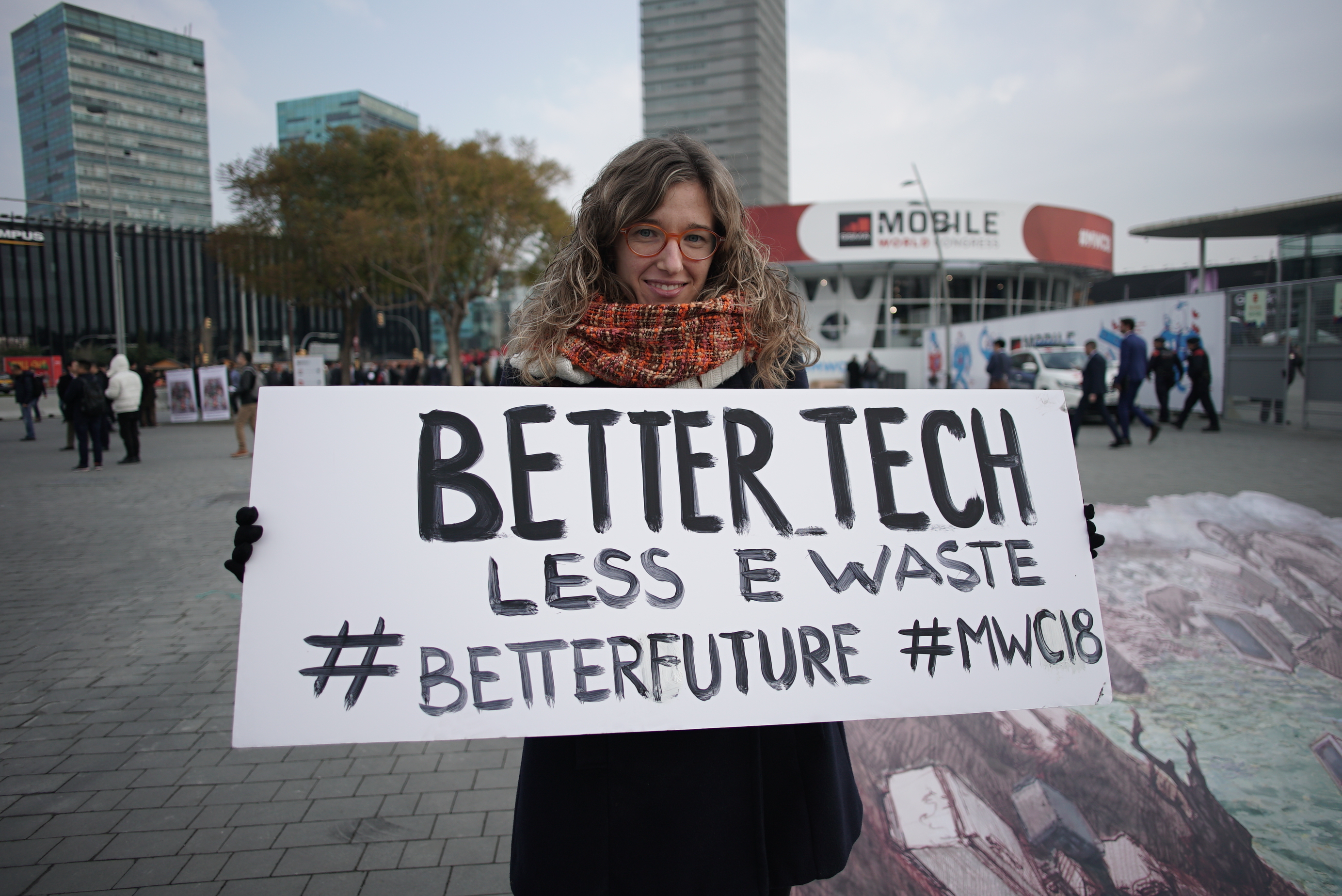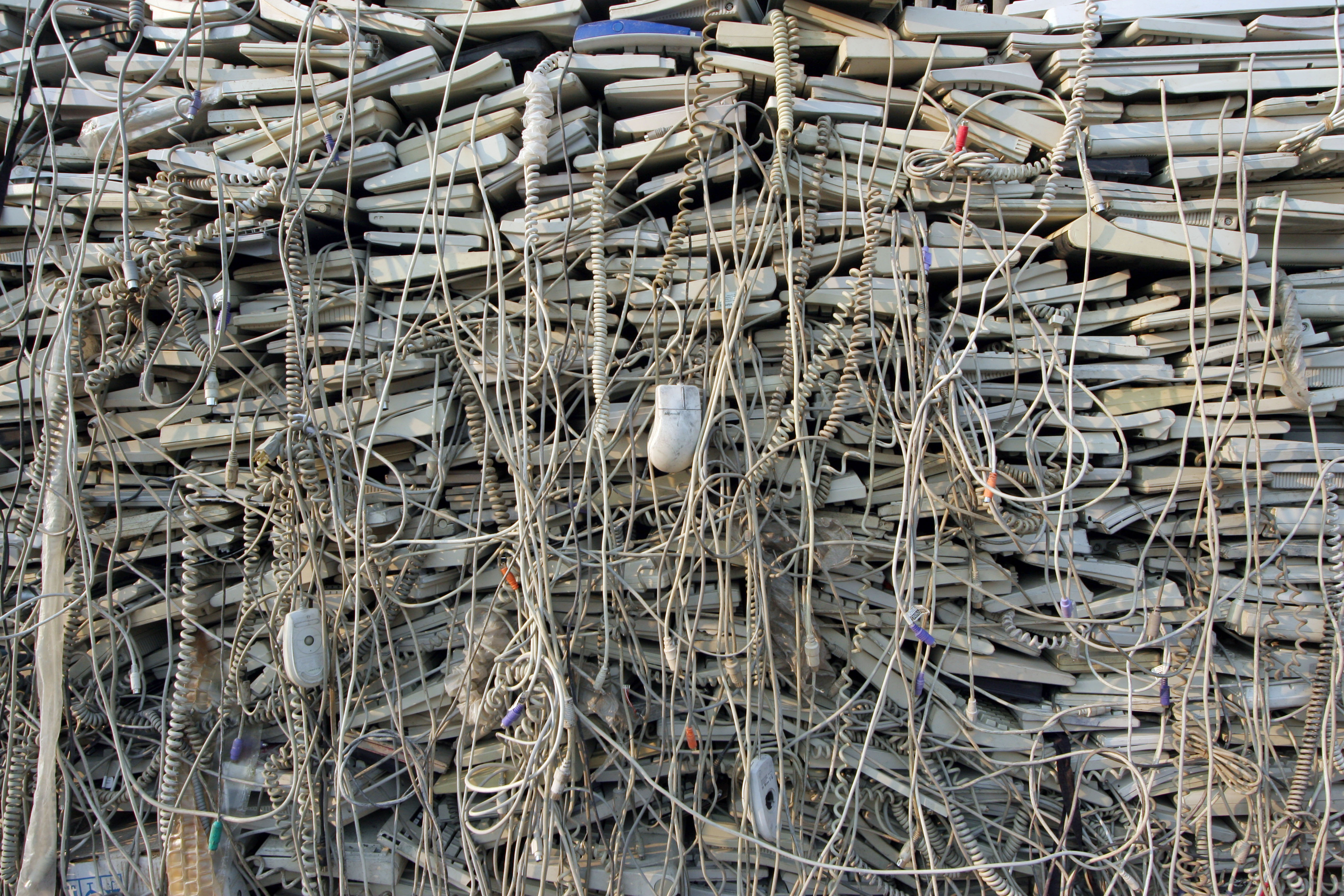While the world’s largest tech companies were showcasing their newest devices at the Mobile World Congress, activists were camped just outside painting a darker image of the excesses of electronics tied to a now-annual upgrade cycle.
The activists, who are part of the European Environmental Bureau and Eco Union NGOs, are calling on tech firms to adopt more sustainable manufacturing practices like closed loop recycling—where recycled materials are reused in the same type of products—and designing for and encouraging device repair.
Videos by VICE
The flashiest part of this protest is a piece of 3D street art by Argentinian artist Eduardo Relero, which is meant to show e-waste piled up in landfills. The intent is to criticize big tech companies for making devices that are difficult to repair, full of rare-Earth elements that must be mined from all over the world, and that have short lifespans.

“We want to expose the darker side to the glitz and glam at tech conferences like MWC,” EEB press officer Jack Hunter told Motherboard in an email. “Pictures of smoky hellholes that pass for recycling centres in the developing world have I think got into the public consciousness.”
The four-day event is among the world’s largest mobile phone conference and features heavyweight keynote speakers like World Bank President Jim Yong Kim and FCC Commissioner Ajit Pai. While the conference leaders have preached sustainability under the hashtag #BetterFuture, protesters say that modern electronics are designed to be disposable and that many electronics are designed with planned obsolescence in mind.
Foremost among the NGO’s concerns are lobbying efforts used by major tech companies like Apple to lobby against the Right to Repair—a growing movement which seeks to empower customers and third parties the ability to open, repair and modify their devices.

“Repair equals tampering to these guys,” Hunter said. “The focus is on [the] compact and slimline, on super strong glues, and tamper-proof screws … Good consumers are supposed to put their ‘old’ phone in the top draw and buy the latest thing, as seen at MWC.”
According to the EEB, conference organizers GSMA did not want to allow them to display anything inside the conference.
“MWC ignored our requests for a platform over a week,” Hunter said. “We got an email saying that giving visibility to our artwork ‘is not a priority for us right now’ … perhaps they feared that our message would make a mockery of their green claims.”
GSMA Marketing and Communications Director Matt Ablott told Motherboard in an email that he was unable to determine if permission had been granted to the demonstrators.

Ablott said that the the mobile industry takes the issues of electronic waste seriously.
“We are constantly implementing initiatives steps to reduce our emissions,” he said. “For example ensuring that all GSMA features, print materials and other materials used, are made from recycled materials or are recycled after use; and using state-of-the-art waste management to recycle almost 80 percent of waste created during the event. We encourage our exhibitors to reduce their carbon footprint by participating in the Green Stand Initiative for the stands with the lowest carbon footprint.”
But a study released last year shows that big tech companies—many of which are presenting at MWC—have systematically lobbied to destroy green electronics standards, and no major electronics company currently support right to repair.
Hunter said that the EEB reached out to Relero in order to create something that felt human to contrast the glam of the conference.
“We knew that all the images coming from MWC would be shiny, futuristic, neon,” Hunter said. “We wanted something human, political, so Eduardo was the perfect choice.”

Hunter said he hopes the demonstration will help expose what he sees as the darker side of these large tech conferences.
“We’re not trying to guilt trip customers,” he said. “They are victims too of a system making things that are basically designed to break.”
Criticism aimed at tech companies over short lifespans and difficult-to-repair devices have gained steam in recent years.
Apple most recently made headlines in December when it was revealed that the company throttles the speed of iPhones as their batteries degrade. This led some consumers to complain that Apple was intentionally shortening the lifespan of its devices to pressure consumers to buy their newest products.
The EEB’s demands for lengthier device lifespans and greater third party repair options has been echoed by consumers and policy makers in the United States. The Right to Repair movement has also made inroads despite sizable tech lobbying efforts to stop it.
Justin Carroll, founder of Fruit Fixed, an independent electronics repair shop, said he has noticed a change in the attitudes of his customers on this front.
“Our customers used to rush through the door to buy the newest products, often stopping by to show then off,” he said. “Now, we have more customers championing how long they’ve had a device and how much they still love it.”
More
From VICE
-

Rob Dobi/Getty Images -

dvulikaia / Getty Images -

Screenshot: Playstack

